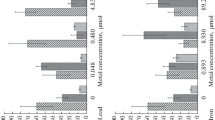Abstract
Experiments were conducted to determine the toxicity of free cupric ion to the eggs of two marine fish: the spot Leiostomus xanthurus, and the Atlantic silverside Menidia menidia. A cupric ion buffer consisting of 5 mM of the chelator, trishydroxymethylamino methane (Tris), and varied concentrations of CuSO4 was employed to achieve stable cupric ion activities in experimental seawater media. Egg hatch of the silverside appears to be more sensitive to cupric ion than that of the spot. The silverside had 60% inhibition of hatch at a pCu (negative logarithum of cupric ion activity) of 9.4 with complete supporession of hatching at pCu values below 8.2, while the spot had 50% inhibition at a pCu of 9.0 and complete suppression at a pCu of 8.0. Cupric ion was most toxic to the eggs of silverside at or around the time of hatching, whereas a pronounced sensitivity at hatching was not apparent with the eggs of spot. Calculated estimates of the range of cupric ion activity in seawater indicate that natural activity levels may in some instances inhibit the hatching of silverside and spot eggs.
Similar content being viewed by others
Literature Cited
Anderson, D.M. and F.M.M. Morel: Copper sensitivity of Gonyaulax tamarensis. Limnol. Oceanogr. 23, 283–295 (1978)
Andrew, R.W., K.E. Biesinger and G.E. Glass: Effects of inorganic complexing on the toxicity of copper to daphnia magna. Wat. Res. 11, 309–315 (1977)
Barber, T.R. and J.H. Ryther: Organ chelator: factors affecting primary production in the Cromwell Current upwelling. J. exp. mar. Biol. Ecol. 3, 191–199 (1969)
Chester, R. and J.H. Stoner: The distribution of zinc, nickel, manganese, cadmium, copper and iron in some surface waters from the world ocean. Mar. Chem. 2, 17–32 (1974)
Steeman Nielsen, E. and S. Wium-Andersen: Copper ions as poison in the sea and freshwater. Mar. Biol. 6, 93–97 (1970)
Stumm, W. and J.J. Morgan: Aquatic chemistry, 583 pp. New York: John Wiley & Sons 1970
Sunda, W.G.: Relationship between cupric ion activity and the toxicity of copper to phytoplankton, 168 pp. Ph.D. thesis, Massachusetts Institute of Technology, Cambridge, Mass. 1975
—, D.W. Engel and R.M. Thuotte: Effects of chemical speciation on the toxicity of cadmium to grass shrimp Palaemonetes pugio: importance of free cadmium ion. Envir. Sci. Technol. 12, 109–113 (1978)
— and R.R.L. Guillard: The relationship between cupric ion activity and the toxicity of copper to phytoplankton. J. mar. Res. 34, 511–529 (1976)
Sunda, W.G. and J.M. Lewis: Effect of complexation by natural organic ligands on the toxicity of copper to a unicellular alga, Monochrysis lutheri. Limnol. Oceanogr. (In press)
Author information
Authors and Affiliations
Additional information
Communicated by M.R. Tripp, Newark
Rights and permissions
About this article
Cite this article
Engel, D.W., Sunda, W.G. Toxicity of cupric lon to eggs of the spot Leiostomus xanthurus and the Atlantic silverside Menidia menidia . Marine Biology 50, 121–126 (1979). https://doi.org/10.1007/BF00397816
Accepted:
Issue Date:
DOI: https://doi.org/10.1007/BF00397816




